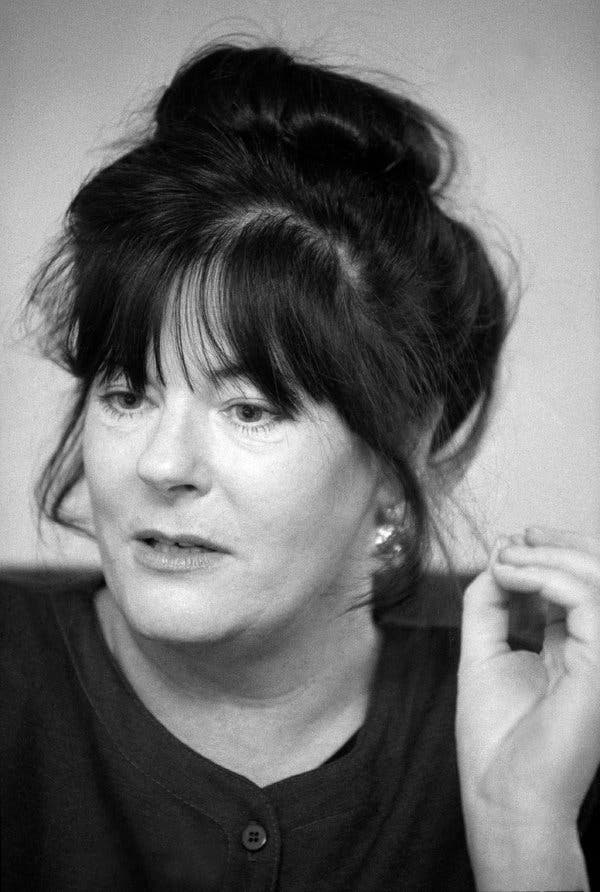Min Hogg, founding editor of The World of Interiors magazine, the beloved, sumptuous chronicle of old world bohemianism, died on Monday at her home in London. She was 80.
The cause was cancer, said Molly Alexander, a great-niece.
Raised in quasi-aristocratic affluence, Ms. Hogg had been working as a fashion editor and a photographer’s agent when she answered an ad in 1981 seeking someone to edit a decorating magazine. She got the job. Interiors, as the publication was first called, was a fledgling operation in an office above a florist’s shop, and it was Ms. Hogg’s job to supply the furniture as well as the editorial copy.
“I decided everything should be in blue and white,” she told London Magazine in 2012. “It ended up looking jolly good.”
After six months, Condé Nast bought a half interest in the magazine and changed its title to The World of Interiors. It bought it outright in 1988.
Charismatic and exacting, Ms. Hogg was committed to producing a magazine about idiosyncratic interiors — a squatter’s stable, an Irish castle, a Finnish egg farm — rather than sleekly decorated spaces. There would be no how-to articles, or tips on decorating with sheets.
“I try to get nonprofessionals who aren’t going to use interior-design jargon and words like silk slub,” she told The New York Times in 1983. “What we end up with instead is a story on a couple who say they used heavy shutters on their windows because they stay in bed all day and like to sleep. Do you see?”
Ms. Hogg’s magazine became a bible of what is reductively known as shabby chic. In its vivid pages, always of heavy stock, “a certain sort of mellow and knocked-about English country house predominated, interspersed with Moroccan riads, Scandinavian palaces and Austrian schlosses,” Nicholas Coleridge, chairman of Condé Nast Britain, said on Instagram after Ms. Hogg’s death.
“Min detested market research, cover lines, interference, anything commercial,” he wrote. “When Condé Nast later purchased the American magazine Architectural Digest, Min declared, ‘Now we know for certain that Condé Nast has no taste.’ ”
In 2000, Ms. Hogg turned the magazine over to her protégé, Rupert Thomas, who remains its editor. She opened her own wallpaper and fabric studio in 2010.
Mr. Coleridge added in a phone interview, “She lived in kind of Venn diagram of louche British aristocracy, louche Bahamian socialites and louche decorators.”
Ms. Hogg dated, among others, the British photographer Ray Rathbone, who died in 2017, and the director John Huston, whose 9-year-old daughter, the future actress Anjelica Huston, would clomp around in Ms. Hogg’s high heels and fishnet stockings.
“Min was the first really glamorous and modern woman I ever saw,” Ms. Huston said in a phone interview. “She was my first beatnik. She must have been in her early 20s, with a curtain of black hair to her waist. She wore miniskirts and kohl around her eyes and those fishnets, and I would just gaze and gaze at her.”

CreditMarilynn K. Yee/The New York Times
Georgina Rose Hogg was born in London on Sept. 28, 1938, to Sir James Cecil Hogg and Pollie (Dalby) Hogg. (Her mother’s first name is sometimes spelled Polly.) Her father was an ear, nose and throat specialist who counted royal family members among his patients. (How she acquired the nickname Min is unclear.)
After boarding school, Ms. Hogg attended what is now the Central Saint Martins school of art and design in London, where one of her professors was Terence Conran, the designer and later retailing magnate. His wife at the time, Caroline Conran, the home editor of Queen magazine, hired Ms. Hogg as a typist. Ms. Hogg went on to work at the British newspaper The Observer and as a photographer’s agent before returning to Harpers & Queen, as the magazine had been renamed, as its fashion editor. Her assistant was a young Anna Wintour, and the two famously did not get along.
“Anna rightly suspected that fashion was not my passion,” Ms. Hogg told London Magazine.
Though The World of Interiors had an influential readership, including Paloma Picasso, Jacqueline Onassis and Bill Blass, the magazine’s circulation was never large (it now has 55,091 subscribers). But it always punched above its weight, said Jonathan Newhouse, chairman of Condé Nast. It remains a proud print stalwart in the digital age.
Ms. Hogg’s survivors include her brother, James Hogg.
For her, “originality of character always mattered more than splashy, cashy decorator schemes (though she included those, too),” Mr. Thomas, the current editor, said in an internal email to staff members. “It was a scintillating and hitherto unseen mix that was frequently imitated but never quite equaled.”
Ms. Hogg always made it known who was in charge.
“Once we had to take away an office which Min had been using for a conference room and give it to the circulation department,” Mr. Newhouse said in an email interview. “Min was furious and threatened to quit.”
As Mr. Coleridge, the magazine’s editorial director at the time, struggled to find a replacement editor, he called Ms. Hogg to ask if she had made up her mind for sure.
“Min said, no, she would stay,” Mr. Newhouse said, “but she was so upset, she needed to take the next three weeks off.”







